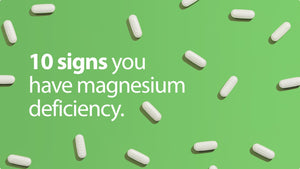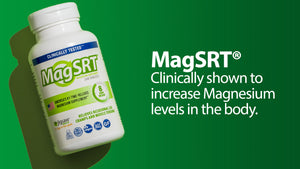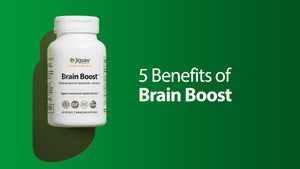When does the body use Carbs for fuel? What about Fats?
Thomas DeLauer breaks down the science behind how our body uses carbs & fats for fuel, and how to use this to your advantage on the latest #ScienceSaturday
Make sure you are meeting the RDI 400mg of Magnesium per day with Jigsaw's MagSRT™ – America's #1 Time-Release Magnesium Supplement.
Click here to add 3 bottles of Jigsaw MagSRT™ to your cart and save $20.94 + $10 off.
Transcript by Rev.com
- What's going on, Jigsaw land? It's Thomas DeLauer, and today I'm dropping some science on you when it comes down to aerobic metabolism and anaerobic metabolism and when your body is using carbs and when your body is using fats. Of course, magnesium comes into play with all of this, because, as you well know, magnesium is involved in over 300 different enzymatic processes within the body, and that includes creating ATP. So let's get down to the science of when you're using fats, carbs, and protein as a source of fuel.
-Okay, so first and foremost, adenosine triphosphate is essentially a phosphate bond that has been broken up, and that releases energy within the body. Now, it's a very abbreviated version, and I've done other videos that go into a lot more detail on that. But for the sake of this video, this is all you really need to know. Okay, so when we look at ATP, it is the ultimate energy source within the body. Everything that we do boils down to using ATP. But there are a couple different means to get there. You see, the first one is gonna be called aerobic metabolism and the second one is gonna be called anerobic metabolism, and they have two very unique systems within the body that ultimately boil down to creating ATP. It's just two different means of getting there.
-The first one is going to be aerobic metabolism, and that occurs when the body has enough oxygen available to ultimately create energy. So when we look at how glucose is used, carbohydrates, carbohydrates are consumed and broken down into glucose. Then that glucose is converted into something called pyruvate. You might remember this from sophomore biology class. Now, that pyruvate is created through something known as the Krebs cycle, which I'm not going to explain in this video 'cause it's boring. But pyruvate ultimately enters what is called the mitochondria and then combines with oxygen to essentially create energy. And the byproducts end up being carbon dioxide and water.
-That's why when you breathe through aerobic metabolism, you end up expelling that carbon dioxide, along with moisture. Okay, it's simply a byproduct of carbohydrate metabolism or fat metabolism going through the simple aerobic system. Now, the cool thing is this is a very efficient system. The bad thing is it's slow. So when we need energy fast, like when we're sprinting or lifting weights, we have to rely on a different energy source. See, sometimes the amount of oxygen can't keep up with how fast the body needs to create energy, so that's why we have the other system called the lactic acid system, and that's where glucose is used a little bit differently. This is called anerobic activity. And this anerobic activity takes glucose and it breaks down again into pyruvate, except instead of that pyruvate going into the mitochondria, the pyruvate now goes into the cytoplasm, which is the fluid area of a cell. And then from there it combines and goes through a different chemical reaction and creates lactate. This is essentially what is creating energy through the anerobic system, and that byproduct is lactic acid.
-That's why when you're sprinting or whenever you're doing any kind of workout, you don't generally fatigue through respiration. You fatigue through muscle failure by way of lactic acid burn. So that's the difference there. Now, the interesting thing is is that people would think that anerobic activity is more powerful, but if you wanna get technical, it's not nearly as powerful. Using carbohydrates in an anaerobic sense is very inefficient. We just have processes within the body that allow it to happen a little bit easier. But before I go into detail on how that works, it's very, very important that you know that aerobic metabolism can use proteins, it can use fats, and it can use carbohydrates. Anerobic activity can only use carbohydrates. I'm not saying one is better than the other. I lift a lot of weights. I clearly like anerobic activity. But aerobic activity is a lot more universal and a lot more efficient when it comes down to just sustaining life in general.
-So here's what ends up happening when you're in an anerobic state. You see, you consume carbohydrates, your body converts them into pyruvate, and then that pyruvate goes into the cell and creates instant energy. But what you don't realize is that that the process is much less efficient when it comes down to how much ATP is created. You see, aerobic activity, energy that's created with oxygen, creates 10 times more ATP per gram of glucose than the anerobic system does. Let me give you a reference here. Okay, one gram of glucose through the anaerobic system creates approximately three ATP. One gram of glucose through the aerobic system with oxygen ends up yielding 39 ATP. So gram for gram, your glucose goes further with aerobic metabolism.
-So then why is it that people say carbohydrates are good for energy if they're so inefficient? Well, we have additional enzymes within our body that expedite the process. So just because the conversion of glucose into energy is a little bit less when it comes down to using the lactic threshold system, it doesn't necessarily mean that it's bad. We have other enzymes at play that enhance the effect. So basically it's moving it along a little bit faster. The problem with the anaerobic system is that we end up limited by that lactic acid. Again, like I said, if you're ever lifting weights, you feel that lactic acid buildup which causes you to quit. So we can only go so far.
-Now, there are some activities that allow you to utilize both. A good example would be if you were out going for a bike ride. You're predominantly using the aerobic system. You're just cruising along, you're huffing and puffing a little bit, but you're not super exhausted. And then all of a sudden you have to climb up a hill. Well, when you start climbing up the hill, your body has no choice but to tap into the anerobic system. You go into what is called oxygen debt because your body has been able to sustain energy by utilizing fats, proteins, and carbs and having the time to combine them with oxygen. But then the second you start climbing up a hill, your oxygen demand increases, and eventually you go into oxygen debt where you don't have enough, so your body starts to recruit excess carbohydrates to be able to convert them into ATP. Because at the end of all of this, we still need the ATP.
-So you may be wondering, okay, well, when is my body using fats? Well, it just comes back down to the aerobic system. We cannot use fats when we are doing high-intensity activity. You see, so when we're lifting weights or when we're sprinting, no matter how hard you try, your body's not going to use fats. So you might be wondering, well, why is this good if I'm on a low carb diet or in ketosis? Well, here's where it's important. Any excess carbs that you do consume, carbohydrates that are coming from just spare amounts of carbs that you get through your diet, or maybe you're just going into a ketogenic diet today and you had carbs yesterday, those high-intensity activities are gonna allow you to utilize those carbs and drain those stores so that you get into ketosis faster.
-So the general rule of thumb, if people ask, what kind of workout should you be doing when you're in ketosis, well, you're still gonna wanna do your weight training and your high-intensity activity, because it's gonna drain those carb stores a little bit more. But you also wanna be doing your aerobic activity, because, A, ketones burn really well when it comes down to energy, but, B, fat is going to be burned when you're doing aerobic activity.
-So there you have it, Jigsaw crew. And as always, make sure you click on the link and check out Jigsaw Magnesium's SRT, sustained released magnesium, so that you can make sure you're always getting the minerals that you need to feel and look your best. I'll see you on the next page.




















